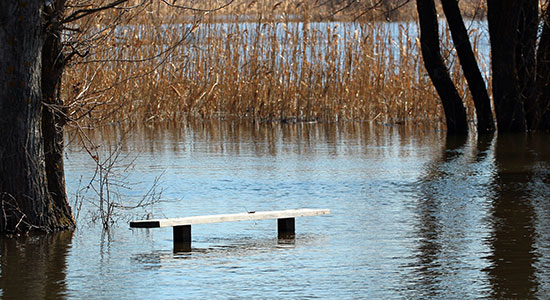
With more than 15,000 lakes, 43,000 miles of rivers, and 659 miles of Great Lakes shoreline, Wisconsin is fortunate to have an abundance of water resources.1 As Aesop’s famous proverb states though, “it is possible to have too much of a good thing.”
In stark contrast to the “mega drought” emerging out west, Wisconsin is experiencing record high water levels in both the Great Lakes and inland sources such as groundwater. Through August, Lake Michigan has set a record high water level every month of 2020.
Current data gathered from NASA’s GRACE-FO satellites demonstrate that Wisconsin is within the highest percentile of groundwater levels in the state’s history.2
As touched on by Larry A. Konopacki and Michael J. Kowalkowski during the Annual Environmental Law Update 2020 from State Bar of Wisconsin PINNACLE®, these record high water levels will no doubt prove to be a source of upcoming litigation for many practices of law.
Attorneys practicing in agriculture, civil, insurance, municipal, property, real estate, and litigation – to name a few – should be aware of this recent water trend, and be prepared to assist their clients and work with local governments.
Recent Extremes
Over the past two decades, the Great Lakes has experienced both record lows and record high water marks. It is not uncommon for the Great Lakes to change water levels by 1 or 2 feet from year to year.
 Caleb Tomaszewski, Marquette 2020, practices in environmental, property, municipal, government law, and general practice.
Caleb Tomaszewski, Marquette 2020, practices in environmental, property, municipal, government law, and general practice.
This changing of water levels is part of larger 13-year cycle of which the Great Lakes and, to a certain extent, inland Wisconsin waters, are a part. These extended periods of low and high-water marks have led to a unique ecosystem of “natural variability” upon which the local plant and animal life depend.3
However, this cycle has seemingly been off for some time now. Between 1999 and 2014, the Great Lakes experienced the longest stretch of record low water levels in history, with Lake Michigan recording its lowest level ever in 2013. These record low water levels are believed to have been the result of the powerful 1997-98 El Niño.
While one unique weather phenomenon caused the record low water levels, another is linked to the current record high water levels: the 2014 January polar vortex. The polar vortex froze large parts of the upper Great Lakes, reducing the amount of evaporation normally experienced in this time. With that spring’s snow melt, lake levels were on the rise from the increased amount of stored water, and Lake Superior’s water rose faster than it ever has. This stored water, coupled with recent above average years of precipitation, has likely led to the Great Lakes’ high-water levels experienced today.
Groundwater has followed a similar trend from the recent above average years of precipitation.
With each year receiving more precipitation then the previous, the local groundwater systems have not been able to catch up and stabilize, resulting in record highs.
Current and Future Issues
The record high water levels on the Great Lakes led to an increase in flood frequency and damage. Properties located on the Great Lakes can be damaged as the shoreline is rapidly being encroached by the rising waters. Encroaching water levels affect the safety of the homes in addition to the property value, and high lake levels lead to severe bluff erosion.
While severe erosion affects property owners along the shoreline in terms of property value, safety and liability concerns, attempts at erosion control can lead to litigation.
In 2008, Concordia University in Mequon completed a $12 million bluff stabilization project. While securing its campus along the shoreline of Lake Michigan, Concordia University was sued by their neighbors.4 They claimed that the erosion control on the University’s property caused increased amounts of erosion on their property.
While most property owners are not able to attempt the same levels of erosion control, any attempt at shoring up a property may have far-reaching consequences.
Inland, record high levels of groundwater pose threats an attorney should consider when engaging with clients. High levels of groundwater can result in the flooding of a client’s property, basement, or local road. Clients who are unfamiliar with flooding may lack the appropriate flood insurance or specific policy due to the natural lowest level identified on the property.
Additionally, high groundwater levels pose a problem to local dams throughout Wisconsin. According to the Wisconsin Department of Natural Resources (DNR), there are approximately 3,900 dams in the state – the majority small drainage control dams on farms.5 Some of these dams are not regulated by the DNR, and likely lack adequate upkeep to withstand the increased pressure from high groundwater levels. Failures of these common structures may result in litigation as the washout may damage a neighboring farm or property.
Municipalities are particularly affected by these high water levels. Stormwater drainage systems can become overwhelmed and submerged, resulting in the slowing or stopping of flow. Pressure from elevated ground water can cause damage to a municipality’s water and sewage system, causing failures and high cost repairs. This is a concern for property owners, as some insurance plans do not automatically cover sewage backups.
High water levels can invade a municipality’s waste treatment plant, placing additional stress on the system by increasing the amount of time and energy needed to run pumps and treat the water in the system.
Lastly, some municipalities have invested large amounts of capital into economic and recreational investments such as parks and beaches. Encroaching lake levels threaten these investments and shrink the available space for the public to use.
Regardless of the level of the lakes, any erosion is permanent on the landscape.
The Reasonable Use Rule
One of the main questions that clients will likely ask their attorneys in response to these record high levels of water will be “What is my responsibility in getting rid of the water?”
While the removal of water from property may not seem a traditional “use” of water, such removal does fall under the reasonable use rule. Adopted by the Wisconsin Supreme Court in 1974 in State v. Deetz, the reasonable use rule was thought to match the “realities of modern society …” better than the previous common enemy doctrine.6
The reasonable use rule is further explained in the recent 2009 drainage case, Hocking v. City of Dodgeville, in which Justice Annette Ziegler provides a history and explanation of the reasonable use rule in Wisconsin.7
Oversimplified: Under the reasonable use rule a landowner has the right to use their land in a reasonable manner, but liability can be created if that use is deemed to be unreasonable and harms another person’s property.
In the case of water drainage or pumping of excess water, a client may face liability if the removal of excess water damages or harms a neighbor’s property. This could include unreasonably altering the landscape to drain in the neighbor’s direction or pointing large downspouts and pump hoses at the neighbor’s property.8
Moving Forward
As Wisconsin has experienced these extremes in water levels over the past decade, such volatility will no doubt increase the political climate around water. Water and water-related issues have a habit of creating a tribe mentality around regional bodies of water, even when these bodies are part of the same larger watershed or system.
Any solution will have to balance the technical application with the legal obligations. Public water rights must be considered in addition to any environmental concerns to the ecosystem. Due to the nature of this issue though, solutions may take a few years to see any relevant effect.
Regardless, attorneys of all practice areas should be prepared for the upcoming problems and litigation related to the current record high water levels and the increasingly hot-button issue of water.
Endnotes
1 David Strifling, The Year of Clean Drinking Water in Wisconsin, Marquette University Law School Faculty Blog, Feb. 1, 2019.
2 Each week, NASA generates groundwater and soil moisture indicators based on data received from their GRACE-FO satellites. NASA’s weekly reports can be found on the NASA Grace website.
3 Peter Annin, The Great Lakes Water Wars 39 (rev. ed. 2018).
4 Bryan Polcyn, Neighbors sue Concordia University over bluff damage, Fox6 Milwaukee, July 25, 2013.
5 Dams Overview, Wisconsin Department of Natural Resources.
6 State v. Deetz, 66 Wis. 2d 1, 18, 224 N.W.2d 407, 416 (Wis. 1974).
7 Hocking v. City of Dodgeville, 2009 WI 70, 318 Wis. 2d 681, 768 N.W.2d 552.
8 Id. at ¶21-22.
